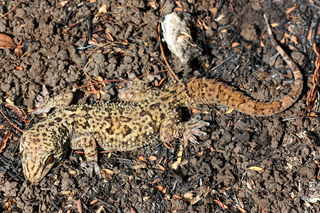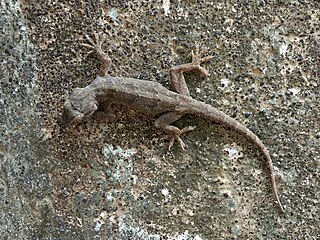
Hemidactylus brookii, commonly known as Brooke's house gecko or spotted house gecko, is a widespread species of gecko.

Hemidactylus maculatus, also known as the spotted leaf-toed gecko or giant spotted gecko, is a species of large gecko found in the Western Ghats of India and in parts of Sri Lanka.

Leschenault's leaf-toed gecko is a species of gecko, a lizard in the family Gekkonidae. The species is endemic to South Asia and parts of West Asia. It is often found inside homes. Its scientific name commemorates French botanist Jean Baptiste Leschenault de la Tour.
The graceful lead-toed gecko is a species of small-sized gecko found in India. The holotype was described in British India in Berar.

Hemidactylus persicus, also known as the Persian leaf-toed gecko or Persian gecko, is a species of gecko found in West Asia.

The scaly gecko is a species of nocturnal, terrestrial, insectivorous gecko found in South India and northern Sri Lanka. This species was first discovered in the coastal sand dunes of Ramanathapuram in Tamil Nadu. Subsequently, it was incorrectly identified and only recently, elaborate descriptions and molecular data are available, enabling a proper identification.
Hemidactylus subtriedrus, also known as Jerdon's gecko or Madras blotched gecko, is a species of gecko found in India and Sri Lanka.

Hemidactylus triedrus, also known as the termite hill gecko, Dakota's leaf-toed gecko, or blotched house gecko, is a species of gecko found in South Asia. The race lankae of Sri Lanka, is now given species status and known as Hemidactylus lankae
Cyrtodactylus soba, also known as the Dumbara bent-toed gecko or Knuckles bent-toed gecko, is a species of gecko endemic to island of Sri Lanka.

Hemidactylus depressus, also known as Sri Lanka leaf-nosed gecko or Kandyan gecko, is a species of gecko endemic to island of Sri Lanka.
The spotted giant gecko is a species of gecko endemic to island of Sri Lanka.
Pseudophilautus singu is a species of frog in the family Rhacophoridae, endemic to southwestern Sri Lanka. It is known from the Kanneliya-Dediyagala-Nakiyadeniya, Kitulgala, and Kottawa Forest Reserves and from the Sinharaja World Heritage Site. The specific name singu is Sinhalese for "horn" and refers to the horn-like tubercles on the upper eyelids of this frog. Common name Sri Lanka short-horned shrub frog has been coined for it.
Hemidactylus boavistensis, the Boa Vista leaf-toed gecko, is a species of gecko in the family Gekkonidae. The species is endemic to the Cape Verde Islands. The specific name, boavistensis, refers to the island Boa Vista, one of the islands where it has been found. It has also been found on the island Sal and the islets of Curral Velho and Sal Rei. It had long been considered a subspecies of Hemidactylus bouvieri but was re-elevated as a separate species in 2008.
Cnemaspis nandimithrai, or Nandimithra's day gecko, is a species of diurnal gecko endemic to island of Sri Lanka.
Cnemaspis gotaimbarai, or Gotaimbara's day gecko, is a species of diurnal gecko endemic to island of Sri Lanka.
Cnemaspis kohukumburai, or Kohukumbura's day gecko, is a species of diurnal gecko endemic to island of Sri Lanka.
Cnemaspis hitihamii, or Hitihami's day gecko, is a species of diurnal gecko endemic to island of Sri Lanka.
Cnemaspis butewai, or Butewes’ day gecko, is a species of diurnal gecko endemic to island of Sri Lanka.
Cnemaspis kivulegedarai, or Kivulegedaras’ day gecko, is a species of diurnal gecko endemic to island of Sri Lanka.
Cnemaspis anslemi, or Anslems' day gecko, is a species of diurnal gecko endemic to island of Sri Lanka described from northwestern foothills of Samanalawewa Nature Reserve.






